The Largest Urban Areas in Latin America: Key Cities to Know
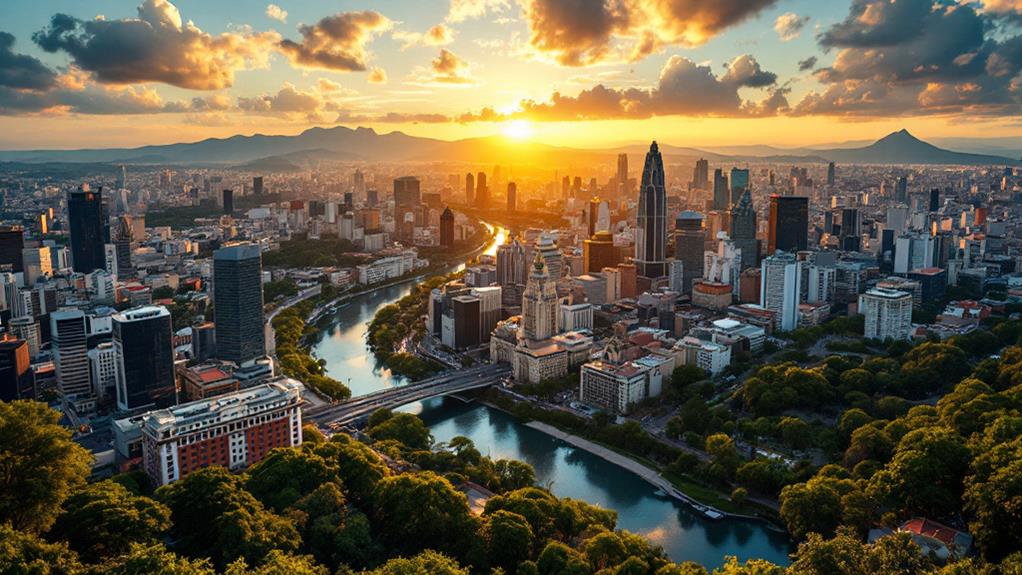
If you're curious about Latin America's largest urban areas, you'll want to know about Mexico City and São Paulo. Mexico City, with a population of around 22 million, is rich in history and boasts an extensive metro network. São Paulo, Brazil's multicultural giant, hosts about 22.4 million residents and is a major economic hub. Don't miss Buenos Aires, the heart of Argentina, famous for its lively cultural scene and tango history. Furthermore, Rio de Janeiro, with its iconic landmarks, and Bogotá, a center of innovation, are key too. Investigate these cities further to uncover their unique blend of tradition and modernity.
Urbanization in Latin America
Although Latin America is renowned for its lively cultural scenes, it's also experiencing a rapid urban transformation. By 2018, an impressive 81.2% of the population in Latin America and the Caribbean lived in urban areas. This trend is expected to rise dramatically, reaching up to 89% by 2050. As a result, cities across the region are evolving at an unprecedented pace, with urban areas becoming focal points of economic and social activity.
Megacities like Mexico City and São Paulo are at the heart of this transformation. These massive urban centers are home to over 10 million residents, representing about 14.2% of the region's population. The growth of these megacities is largely fueled by migration and natural population increase, creating a dynamic yet challenging environment. You'll find urbanization to be a double-edged sword, as it brings opportunities but also demands efficient infrastructure and housing solutions.
As more people flock to urban areas, the need for public services and affordable housing surges. Effective urban planning and sustainable development strategies become essential for creating livable cities. Embracing the diversity within these megacities can pave the way for lively, inclusive communities.
Key Cities by Population
In considering the lively urban landscapes of Latin America, you'll find that São Paulo stands out as the largest, with a staggering 22.4 million residents as of 2022. As the beating heart of Brazil's economy, this metropolitan area offers a unique blend of culture, industry, and diversity. São Paulo is not just a city; it's an essential force driving Latin America's growth.
Following closely is Mexico City, but let's focus on the third-largest urban area, Buenos Aires. Home to approximately 15.3 million people, Buenos Aires is Argentina's dynamic capital, renowned for its rich cultural scene and historical significance. It's a city where European charm meets Latin flair, making it a must-know metropolis in the region.
Next on the list is Rio de Janeiro, Brazil's second-largest city, with a population of about 13.6 million. Famous for its stunning beaches and iconic landmarks like Christ the Redeemer, Rio is a lively hub of activity and tourism. At last, Bogotá, Colombia, with its 11.3 million residents, exemplifies significant urban growth in the largest cities in Latin America. As a thriving metropolitan area, Bogotá is a center of innovation and economic development.
Mexico City Insights
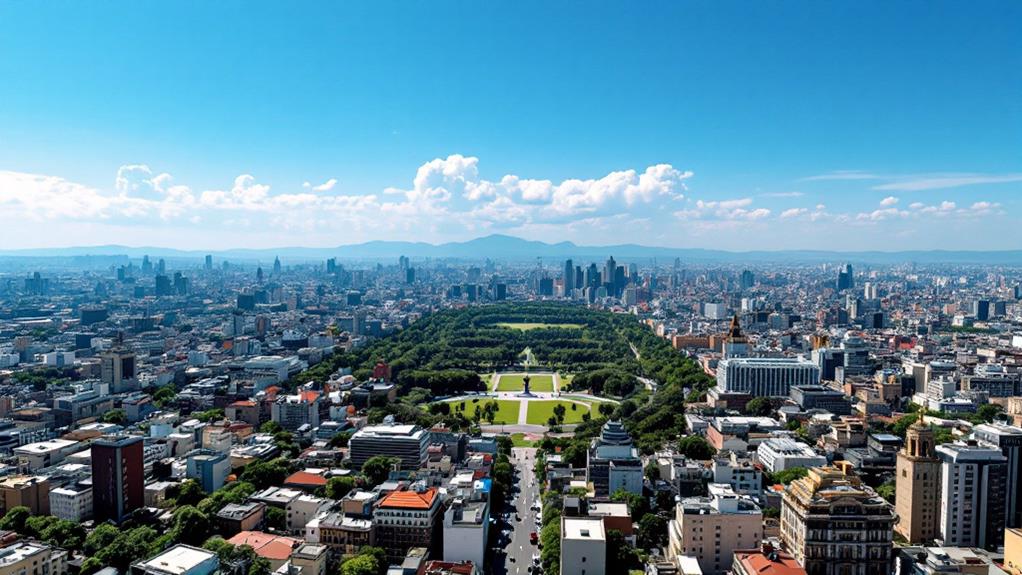
After exploring the lively cityscapes of São Paulo, Buenos Aires, Rio de Janeiro, and Bogotá, let's turn our attention to Mexico City. As the most populous metropolitan area in Latin America, Mexico City is thriving with approximately 22 million residents as of 2022. It's not just the sheer number of people that makes this city stand out; it's also a major economic powerhouse. With a GDP of roughly $490.6 billion and a GDP per capita of $16,239, you can see why it's considered a significant economic hub in the region.
Mexico City isn't just about numbers, though. Founded by the Aztecs in 1325, it offers a rich cultural tapestry, positioning itself as Mexico's cultural, economic, and political center. When you visit, you'll notice the mainly Mestizo population, but there's also a dynamic mix of European descendants and a lively community of expatriates, especially from North America. Getting around is a breeze with the extensive transport system featuring a 229.4-kilometer metro network, efficiently serving around 1.7 million passengers daily. In Mexico City, you'll find a city that's both historically intriguing and vivaciously modern.
Exploring Sao Paulo
São Paulo stands as Brazil's largest city and a key player in the region with a population of around 20.8 million as of 2015. As one of the most influential cities in Latin America, São Paulo boasts a robust economy, with the highest GDP in the region at an impressive $530.9 billion. This economic powerhouse is home to the headquarters of many banks and multinational companies, cementing its status as a major financial center.
You'll find São Paulo's vibrancy in its multiculturalism. About 60% of its residents have Italian ancestry, showcasing a rich tapestry of immigrant history. This diverse background contributes to its dynamic arts and culinary scenes, drawing people from around the globe. Since 2010, approximately 3 million immigrants have added their flavors and traditions to this lively metropolis.
When exploring São Paulo, you're not just visiting a city; you're experiencing a cultural mosaic that's constantly evolving. Its influence extends beyond economy and finance, making it a lighthouse of culture among cities in Latin America. Regardless of your interest in business, arts, or cuisine, São Paulo offers a unique and exciting experience that reflects the spirit of Latin America.
Buenos Aires Highlights
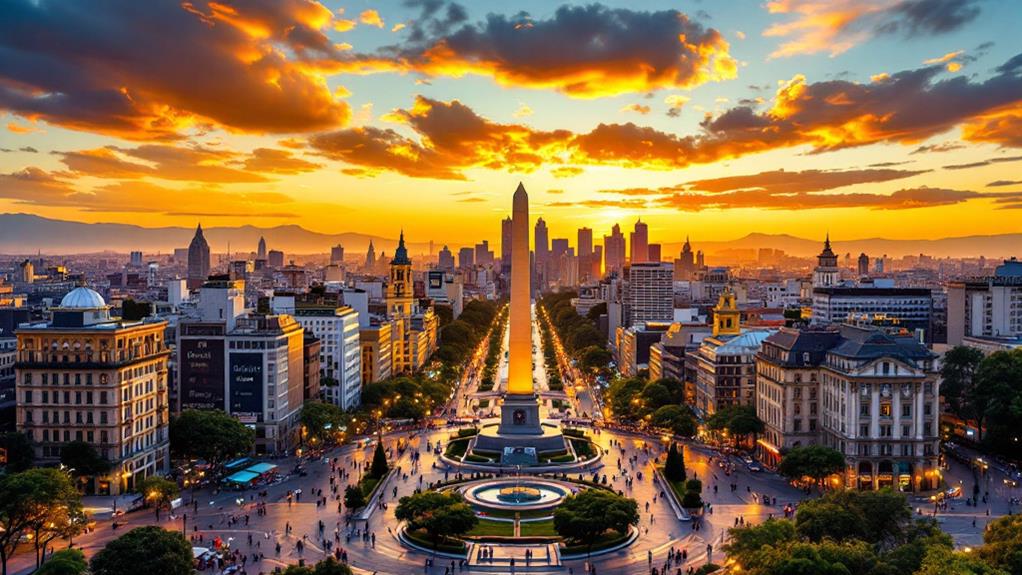
Buenos Aires, Argentina's largest city, captivates with its lively mix of history and modernity. As one of the major Latin American cities, it boasts a population of approximately 15,481,800 as of 2015. This dynamic metropolis is not just about numbers; it's a reflection of Argentina's economic prowess with the highest per capita GDP in the region at $35,906. Such economic energy makes Buenos Aires a crucial player among Latin American cities.
Walking through Buenos Aires, you'll notice how its rich history is interwoven with modern living. Around 60% of its residents live in apartment buildings, reflecting both its urban density and unique architectural style. This city is a living canvas of historical influences, largely shaped by Italian and Spanish immigrants since the 19th century. Their cultural contributions have given Buenos Aires its distinct identity, celebrated through its lively arts scene.
Being the birthplace of tango, Buenos Aires pulsates with rhythm. The city hosts numerous theaters and cultural events, making it a must-visit for anyone interested in arts and culture. Regardless of your interest in its history or immersing yourself in its art, Buenos Aires offers an unforgettable experience.
Rio De Janeiro Overview
Situated between lush mountains and the Atlantic Ocean, Rio de Janeiro stands as one of the most lively cities in Latin America. With a metropolitan population of approximately 12,460,200, it ranks among the most populous urban areas in the region. You're likely familiar with its iconic landmarks, such as the towering Christ the Redeemer statue and the majestic Sugarloaf Mountain, both of which draw millions of visitors annually. These symbols not only define the city's skyline but also reflect its rich history and cultural significance.
In the 17th century, Rio de Janeiro played an essential role as a major port for gold shipment. It later served as Brazil's capital until 1960, shaping its development and prestige. Today, Rio is synonymous with its lively cultural scene, particularly the world-famous Carnival. This annual festival bursts with color, samba music, and intricate parades, offering you an unforgettable spectacle.
The city's geography is similarly stunning, featuring renowned beaches like Copacabana and Ipanema. These coastal gems, set against a backdrop of mountainous terrain, create a unique urban landscape that captures the essence of Rio's energetic and diverse spirit.
Bogota's Cultural Impact
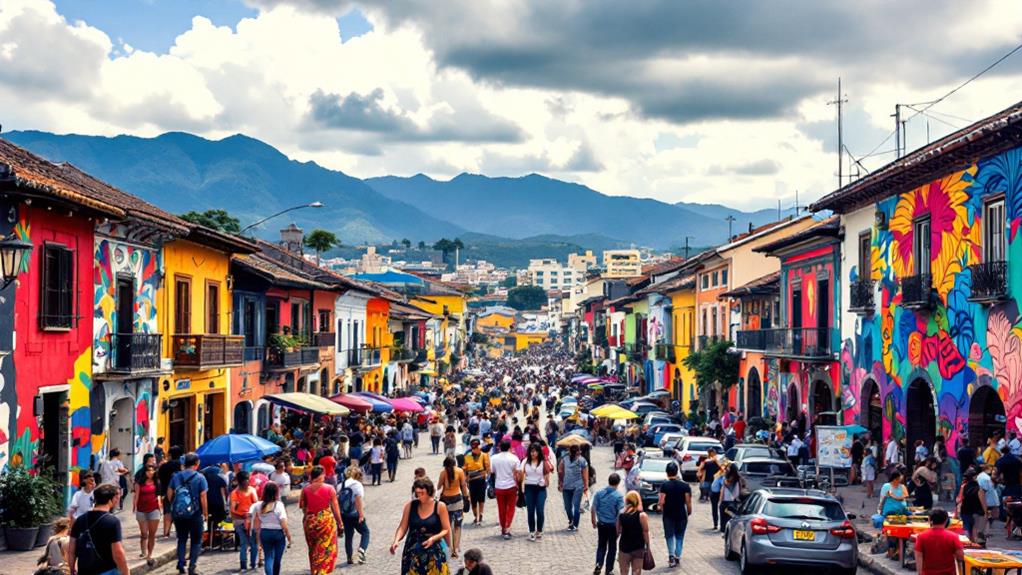
Often referred to as the "Athens of South America," Bogotá captivates with its rich cultural scene that you can explore through its many museums, theaters, and art galleries. One of the must-visit places is the renowned Gold Museum, where you'll find an extensive collection of pre-Columbian gold artifacts. These pieces offer a glimpse into Colombia's indigenous cultures, deepening your understanding of the region's history and artistic expression.
As you wander the city, engage yourself in Bogotá's lively street art scene. The murals transform the urban landscape into an open-air gallery, conveying powerful social and political messages that enrich the cultural narrative and resonate with the people living there. It's a constantly changing reflection of the city's dynamic spirit and creativity.
If you're a literary enthusiast, don't miss the annual Bogotá International Book Fair. This event draws people from around the world, underscoring the city's commitment to literature and cultural exchange. Additionally, Bogotá's culinary scene is a delightful exploration of diverse demographics and traditional Colombian dishes. Numerous restaurants celebrate local flavors and ingredients, further shaping the city's cultural identity and offering a taste of its rich heritage.
Lima's Historical Significance
Lima, founded in 1535 by Spanish conquistador Francisco Pizarro, stands as a tribute to the rich tapestry of colonial history in South America. As the capital of the Viceroyalty of Peru, Lima became the central hub for Spanish colonial administration, dramatically influencing the continent's political landscape. The city's historical significance is undeniable, highlighted by its role as a major export center for precious metals, which bolstered Spain's wealth during the colonial period.
When exploring Lima, you'll find:
- UNESCO World Heritage Site: The city's colonial architecture is remarkably well-preserved, offering a glimpse into the fusion of indigenous and Spanish influences.
- Religious Influence: Lima was essential in spreading Catholicism, with numerous churches and an influential archbishopric that still impacts the region today.
- Educational Heritage: The National University of San Marcos, established in 1551, is the oldest university in the Americas and underscores Lima's status as a cultural and educational center.
With a vibrant population of nearly ten million people today, Lima's historical development continues to shape its identity, making it a significant city to understand the intricate history and cultural dynamics of Latin America.
Other Notable Cities
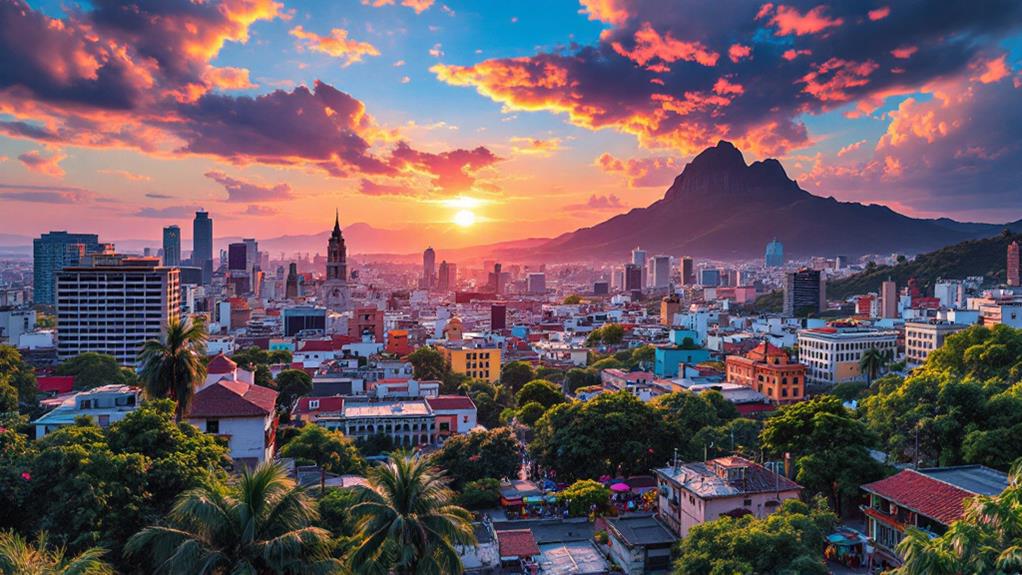
While Lima's historical significance is undeniable, other cities in Latin America also play essential roles in shaping the region's identity. Take Rio de Janeiro, Brazil, for instance. With a total population of approximately 12,460,200, it's not just about its world-famous carnival. Rio's historical roots as a major port city in the 17th century have left an indelible mark on its cultural fabric.
Then there's Bogotá, Colombia, often called the "Athens of South America." With 9,135,800 residents, it's a hub for cultural institutions that echo its rich history since its founding in 1538. Santiago, Chile, with a population of 7,164,400, is another standout. Positioned against the Andes, it thrives as a cultural and economic powerhouse, drawing you in with its breathtaking landscapes and lively life.
Don't overlook Salvador, Brazil. It may have a smaller population of around 2,883,000, but its influence is mighty. Known for its Afro-Brazilian culture and historic architecture, Salvador adds a distinct flavor to the cities of Latin America. Each of these cities contributes distinctly to the total population tapestry of Latin America, offering diverse experiences and histories.
Urban Trends and Projections
Urbanization in Latin America is rapidly picking up steam, with a significant portion of the population already living in cities. By 2050, projections suggest that 89% of the population will reside in urban areas, up from 81.2% in 2018. This growth is fueled by migration and natural population increases, leading to the rise of megacities—urban giants with populations exceeding 10 million. Currently, six such megacities exist in the region, housing 14.2% of its people and acting as crucial economic and cultural centers.
As urbanization accelerates, cities face mounting challenges:
- Environmental Degradation: Increased pollution and waste from dense populations stress natural resources and ecosystems.
- Social Inequality: Rapid growth can exacerbate existing disparities, leaving marginalized communities with limited access to fundamental services.
- Infrastructure Strain: Housing, transportation, and public services experience heightened demand, risking overcapacity and inefficiency.
To combat these issues, sustainable urban development and strategic investment in public services are imperative. By focusing on these areas, you can help guarantee Latin America's cities not only grow but thrive, balancing expansion with quality of life for all residents.



